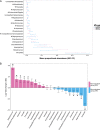Differences in the Nasopharyngeal Microbiome During Acute Respiratory Tract Infection With Human Rhinovirus and Respiratory Syncytial Virus in Infancy
- PMID: 27923952
- PMCID: PMC5142087
- DOI: 10.1093/infdis/jiw456
Differences in the Nasopharyngeal Microbiome During Acute Respiratory Tract Infection With Human Rhinovirus and Respiratory Syncytial Virus in Infancy
Abstract
Respiratory viruses alter the nasopharyngeal microbiome and may be associated with a distinct microbial signature. To test this hypothesis, we compared the nasopharyngeal microbiome of 135 previously healthy infants with acute respiratory infection due to human rhinovirus (HRV; n = 52) or respiratory syncytial virus (RSV; n = 83). The nasopharyngeal microbiome was assessed by sequencing the V4 region of the 16S ribosomal RNA. Respiratory viruses were identified by quantitative reverse-transcription polymerase chain reaction. We found significant differences in the overall taxonomic composition and abundance of certain bacterial genera between infants infected with HRV and those infected with RSV. Our results suggest that respiratory tract viral infections are associated with different nasopharyngeal microbial profiles.
Keywords: children; human rhinovirus; microbiome; nasopharynx; respiratory syncytial virus.
© The Author 2016. Published by Oxford University Press for the Infectious Diseases Society of America. All rights reserved. For permissions, e-mail journals.permissions@oup.com.
Figures

References
Publication types
MeSH terms
Substances
Grants and funding
LinkOut - more resources
Full Text Sources
Other Literature Sources
Medical
Molecular Biology Databases

